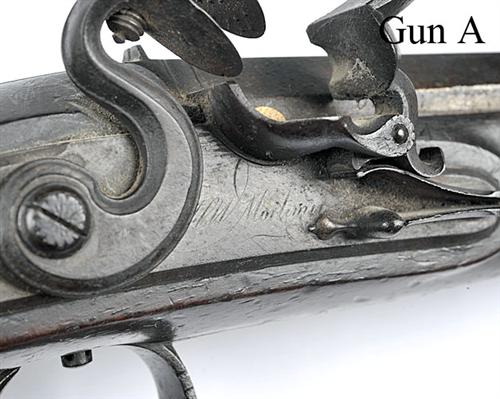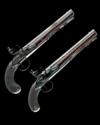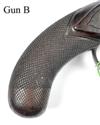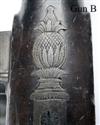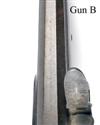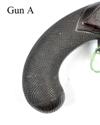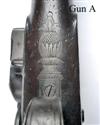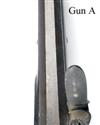Product Details
H. W. MORTIMER, LONDON,
A PAIR OF 25-BORE FLINTLOCK DUELLING PISTOLS, no visible serial no.,
circa 1795, with 10in. slightly swamped octagonal smooth-bore barrels, the top-flats signed 'H. W. MORTIMER LONDON. GUNMAKER TO HIS MAJESTY', slightly curved bevel-edged step-tailed locks signed 'H.W. MORTIMER', bolted safes behind hammers, walnut full-stocks with chequered bag-shaped butts (one pistol stock broken through behind lock and with old inlet repair to pommel), iron border and trophy engraved roll-edged trigger-guards, set triggers (at fault) pineapple finials and original horn-tipped ramrods
Provenance: The vendors family tradition believes these pistols to have once belonged to the notorious Berkhamsted highwayman James Snooks.
The story of highwayman James Snooks is one of the best known in the district.
A notice posted in the London Chronicle in May, 1801 reads........
The post-boy conveying the mail from Tring to Hemel Hempstead, was stopped near Bone End, in the Parish of Northchurch, about fifteen minutes past ten o'clock last night, by a single highwayman mounted on a dark-coloured grey horse, who took from him the following bags of letters for London, viz Winslow, Wendover, Aylesbury, Tring and Berkhamsted.
There is great reason to suspect that one James Snooks committed the robbery. He is a native of Hungerford, where his father now resides, is between 30 and 40 years of age, 5 feet 10 or 11 inches high, has light brown hair cut short, is pitted with the small pox, has lived in and about Mary-le-bone, and is well known in the neighbourhood of Portland Place. He left his lodging at No. 3, in Woodstock Street, Mary-le-bone, early on Saturday morning, and was then dressed in a blue coat, with black velvet collar, marcella waistcoat, with blue and white stripes, velveteen breeches, and dark-coloured stockings. He was tried at the Old Bailey about a year ago, for horse stealing and acquitted. He is supposed to have in his possession several Bank of England notes, Aylesbury, High Wycombe, Uxbridge, Stoney Stratford, and Banbury notes.
Whoever shall apprehend and convict, or cause to be apprehended and convicted, the person committed the said robbery, will be entitled to a reward of two hundred pounds, over and above the reward given by Act of Parliament for apprehending highwaymen: or if any person concerned therein will surrender himself, and make discovery, whereby the person who committed the robbery may be apprehended and brought to justice, such discoverer will be entitled to the said reward, and will also receive His Majesty's most gracious pardon.
By command of his Majesty's Post-master General,
Francis Keeling, Secretary.
Although generally known as Robert (a corruption of 'that robber Snooks'), Snooks was in fact baptised James at Hungerford, Berkshire on Sunday 16th August 1761. It is possible that during his early career he worked as an ostler at the King's Arms, Berkhamsted and, if so, his employer, John Page, was destined to meet him in an official capacity at his eventual execution. In 1800 he was known to be living in Hertfordshire at Hemel Hempstead, and in consequence he would have had the opportunity to become familiar with movements on and around Boxmoor Common. One person who would have undoubtedly caught his eye would have been John Stevens, the post boy employed to carry mail across the lonely heathland. Selecting a suitably dark night, Snooks waylaid Stevens as he crossed the common, relieving him with relative ease of his six mailbags, which contained not only letters but bank and promissory notes - the bags were left scattered over the Moor. It is not known whether he chose that particular night carefully or whether it was pure good fortune, but the contents of the bags were exceptionally heavy, one letter alone containing over £500 in notes. Leaving for Southwark unrecognised, Snooks had achieved what he felt to be the perfect crime, indeed but for one small mistake he would probably have remained undetected.
Some time after the robbery, feeling that all the excitement had died down, he despatched a servant to purchase him some cloth, charging her to bring him the change from a £5 note. In error he handed her a £50 note, a fact which aroused great suspicion with the trader. Aware of enquiries now being made about him, Snooks fled back to Hungerford, but was later spotted in Marlborough Forest nearby and arrested.
Found guilty under his baptismal name at Hertford Assizes, he was sentenced to be hung in chains at a site selected by Mr. Page, now High Constable of the Hundreds of Dacorum. However, the period for such grisly displays was drawing to a close and after a petition by the residents of Boxmoor, the selected location, this was commuted to a straightforward execution.
A local holiday was declared on the appointed day, March 11th, 1802, crowds assembling from early morning. Stopping for a final drink en route to his execution - possibly at The Swan - Snooks is reputed to have rebuked the crowds, telling them that there would be no fun until he arrived. Standing before the gallows it is said he offered his gold watch to anyone prepared to assure him a decent burial.
This bargain not being accepted, he was hung from one of a group of five horse chestnut trees. After he was cut down, a truss of straw was divided, half being tossed into the grave. As the body was placed upon this a disgraceful scene ensued as the executioner started to strip the clothes of the corpse claiming it to be his privilege. The High Constable, determined to preserve a sense of decency, prevented this, the remaining straw then being placed over the body and the grave filled in.
The following day it would appear that the local residents repented and subscribed to a plain wooden coffin. Snooks was exhumed, placed in the coffin and reinterred at the same spot. He holds the macabre distinction of being the last highwayman in England to be hanged at the scene of his crime.
Estimate £2,500-4,000

